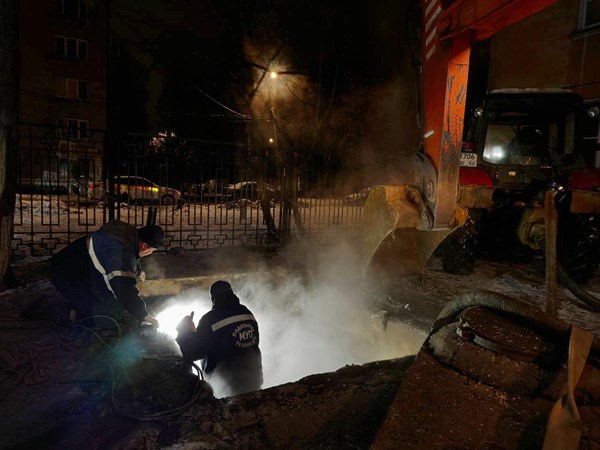As Kremlin continues funding Ukraine war, Russia grapples with systemic heating pipeline failures
Heating pipeline ruptures continue in Russia. This seasonal occurrence has been sparked this year by record-breaking low temperatures, experts say. However, they add, the problem is systemic in nature and is getting worse each year. Specifically, the extensive repair work on heating pipelines indicates the serious nature of the breakdowns.
Depending on the region, the wear and tear of heat supply systems range from thirty to seventy percent. In the coming years, the lion's share of the budget will be allocated to military purposes, and expenditures on housing and utilities will fall to record lows over the past six years. The burden on the heating pipelines will increase annually, considering the active pace of new housing developments, meaning the country will face new municipal collapses in the future.
The largest utility accident occurred with a pipeline rupture in Podolsk, where a boiler plant at Klimovsk Specialized Ammunition Factory failed. For nearly four days, thousands of residents were left without heat. Authorities blamed the factory's shareholders for the incident and brought two defendants to trial: the plant's boiler chief Alexander Chikov and the deputy head of Podolsk's administration, Roman Ryazantsev. On January 17th, the governor of the Moscow region reported that heat had been restored to all homes.
Following Moscow's suburbs, major breaks in heating pipelines occurred in other regions of Russia as well. Among the most recent incidents was a major rupture of a heat supply network in Novosibirsk, where about 400 buildings, including schools, hospitals, and kindergartens, were left without heat, and a street was flooded by boiling water from a raptured pipe. It was discovered that a pipe laid back in 1974 had burst. A similar accident occurred in Nizhny Novgorod, where 16 people, including two children, suffered burns from hot water flooding the street. Thousands of citizens were also left without heating. The newspaper "7x7" reported that this year accidents in the heating supply system have occurred in at least 43 subjects of the Russian Federation.
In some regions, citizens' discontent has taken the form of protests. In Elektrostal near Moscow, people lit fires in the courtyards and published videos on social media, shouting "We're freezing." The campaign went viral online and caught the attention of the authorities. The heating issue was resolved, and two days later, the fires in the courtyards were extinguished.
An activist in Novosibirsk requested permission from the city mayor's office to hold a rally in response to the utility accidents and the general state of municipal services in the city. As expected, permission was denied, with officials unusually stating that the event "poses a threat to human rights and freedoms and public safety, including the constitutional order".
Elsewhere in Russia, people quietly endure the cold in their apartments.
Heating pipeline ruptures are one of the seasonal problems to which Russia's population has partly become accustomed, hence the lack of notable protests, explains Vladimir Gelman, a political scientist and professor at the University of Helsinki. This is largely due to the fact that regional authorities are effectively appointed by the federal center, he says, and are not accountable to the residents: "They have no strong incentives to care about the well-being of citizens."
From time to time, the Kremlin intervenes, conspicuously punishing regional officials, with Putin himself taking the situation under his "personal control." However, this does not change the systemic nature of the problem, Gelman asserts. Given the rigid power structure, local officials are incapable of influencing the allocation of sufficient funds for the repair of the heat supply infrastructure, the political scientist concludes.
In 2022, the Russian prime minister, Mikhail Mishustin, held a government meeting to discuss the "housing strategy" up to 2030. It was noted that in 2021 Russia achieved a record pace in the commissioning of new housing in its history—92.6 million square meters, half of which were apartment buildings.
According to the report, the main problem facing, among others, growing microdistricts is the load on existing heating networks, which on average show 30 percent wear. Approximately 50 of the 167 thousand kilometers of new pipelines are required. An average of 6,600 incidents occur monthly, and repairs take about ten hours. The report states that the situation will deteriorate in the coming years, with infrastructure aging by 3 percent annually, while funding will cover only 1-2 percent of repairs.
Private business could support the situation, officials believe. Modernizing infrastructure could be done as public-private partnerships, later allowing entrepreneurs to profit from their operation. However, businesses are not interested in investing in such projects in small towns and cities, the report mentions, and the population and organizations' debt for housing and utility services has already exceeded 1.5 trillion rubles.
Business is wary of losses, particularly in regions where strict tariff policies are in place, explains financial analyst Dmitry Kumanovsky. For this reason, he says, Gazprom at the end of last year sold its heating company GUP TEK to the city of St. Petersburg. If tariffs were not regulated, the cost of housing and utilities would skyrocket, he surmises.
"Without subsidies from regional authorities and combined heat and power production (during electricity generation), as well as in individual boiler houses, it is economically disadvantageous," he says.
Last year, the State Duma approved Russia's budget, which until 2026 gives top priority to military expenditures. About 30 percent of the 10.8 trillion expenditure (6 percent of GDP) will go to national defense. Attention to social and communal sectors will be downgraded for the first time. Meanwhile, a radical reduction in spending on housing and communal services is planned. This year, 886 billion rubles
